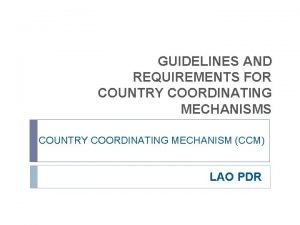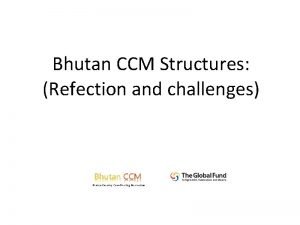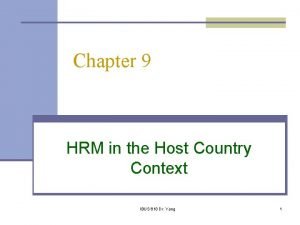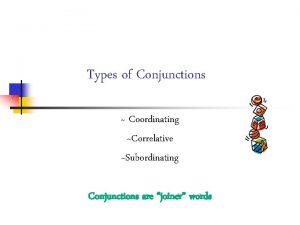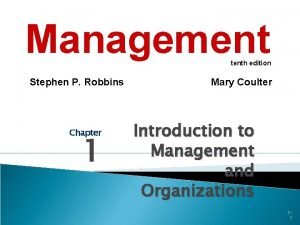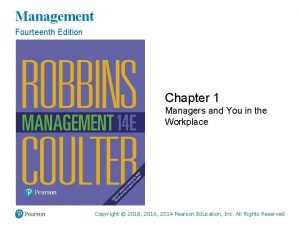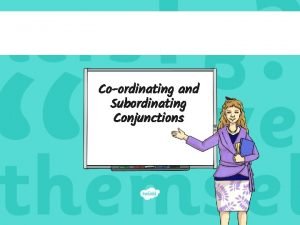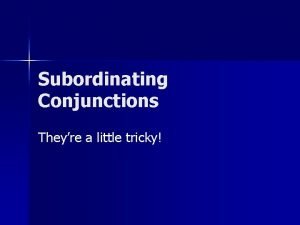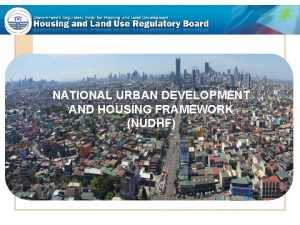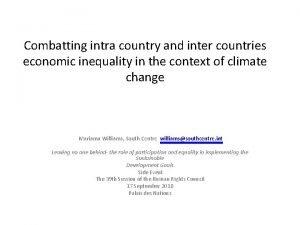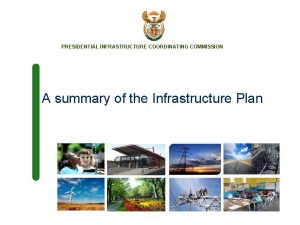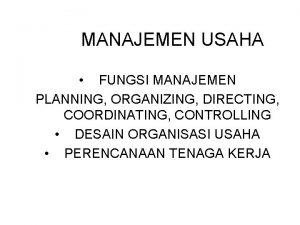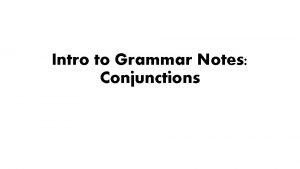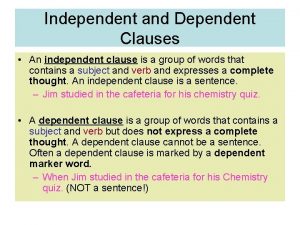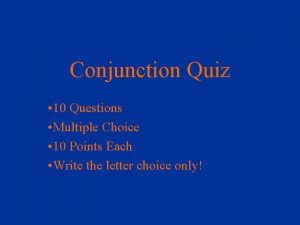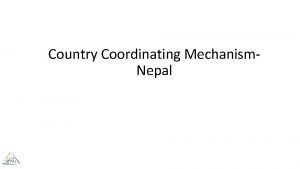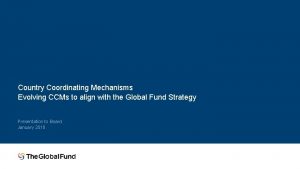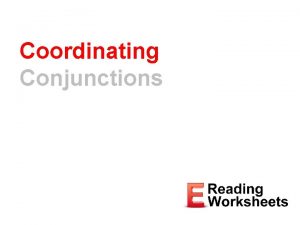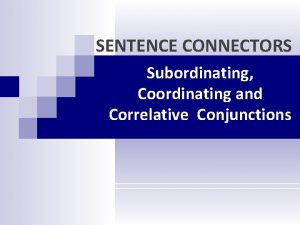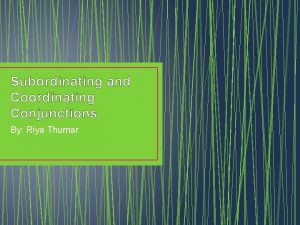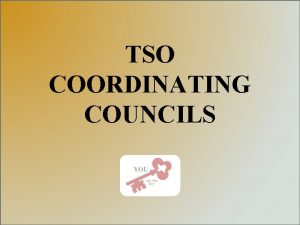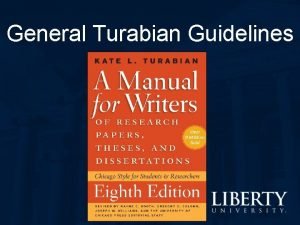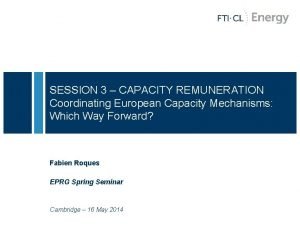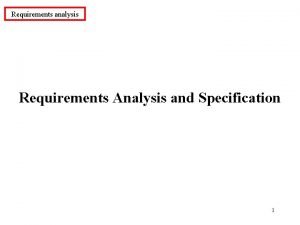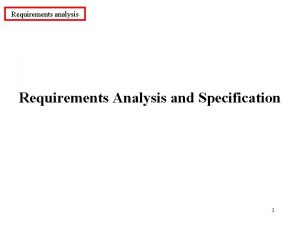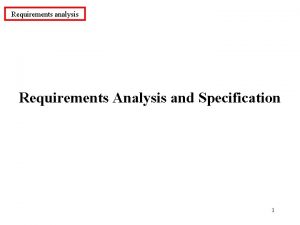GUIDELINES AND REQUIREMENTS FOR COUNTRY COORDINATING MECHANISMS COUNTRY





















- Slides: 21

GUIDELINES AND REQUIREMENTS FOR COUNTRY COORDINATING MECHANISMS COUNTRY COORDINATING MECHANISM (CCM) LAO PDR

Overview of the Global Fund and CCM � The purpose of the Global Fund is “to attract, manage and disburse additional resources through a new publicprivate partnership that will make a sustainable and significant contribution to the reduction of infections, illness and death, thereby mitigating the impact caused by HIV/AIDS, tuberculosis (TB) and malaria in countries in need, and contributing to poverty reduction as part of the Millennium Development Goals (MDGs)”. COUNTRY COORDINATING MECHANISM (CCM) LAO PDR

Overview of the Global Fund and CCM � The Global Fund does not maintain country offices. Instead, it relies on CCMs, principal recipients (PRs) and other local stakeholders to ensure resources are used efficiently to help those most in need. � Each country wishing to apply for funding from the Global Fund must have a CCM that includes representatives from the public and private sectors, civil society and development partners. COUNTRY COORDINATING MECHANISM (CCM) LAO PDR

Key Actors • Country Coordinating mechanism(CCM) • Principal Recipients (PRs) Key Actors in • Sub-Recipients (SRs) Grant Management • The Global Fund Secretariat • Local Fund Agents (LFAs) COUNTRY COORDINATING MECHANISM (CCM) LAO PDR

CCM Eligibility Requirements 1. Transparent and inclusive concept note development process. 2. Open and transparent PR selection process. 3. Overseeing program implementation and having an oversight plan. 4. Document the representation of affected communities. 5. Ensure the representation of non-governmental members through transparent and documented process. 6. Develop, publish and follow a policy to manage conflict of interest that applies to all CCM members, across all CCM functions.

Eligibility Requirement 1 -2 will be assessed at the time of concept note submission 1. Transparent and inclusive concept note development process. 2. Open and transparent PR selection process.

Eligibility Requirements 3 -6 will be submitted as the CCM Self-Assessment 3. Overseeing program implementation and having an oversight plan. 4. Document the representation of affected communities. 5. Ensure the representation of non-governmental members through transparent and documented process. 6. Develop, publish and follow a policy to manage conflict of interest that applies to all CCM members, across all CCM functions.

4. Document the representation of affected communities ER G The CCM ensures adequate representation of key affected populations taking into account the socio-epidemiology of the three diseases INDICATOR CCM membership of key affected and most at risks populations may include representatives of IDUs, MSMs, CSWs, transgender, migrants, etc. either as representatives of organized groups and/or networks or as individual representatives. In countries where these groups are criminalized, CCM has "advocates" instead of direct representation. STATUS CCM Membership List; CCM meeting minutes Compliance Assessment NC - KAP that exist in country are NOT fully represented in the CCM IC - The CCM is in process of electing representatives or renewing membership FC - KAP that exist in country are fully represented in the CCM

4. Document the representation of affected communities ER H The CCM ensures adequate representation of PLWD, taking into account the socio-epidemiology of the three diseases INDICATOR For HIV, civil society members that represent PLWH organization(s)/network(s) For TB and Malaria, civil society members that represent PLWTB/M organization(s)/network(s); or leaders of relevant communities if there are no organized PLWTB/M groups. Number of representatives is determined depending on the disease burden in country. STATUS CCM Membership List Compliance Assessment NC - PLWD are NOT fully represented in the CCM considering the disease burden in country. IC - CCM is in the process of electing representatives or renewing membership FC - PLWD are fully represented in the CCM considering the disease burden in country.

4. Document the representation of affected communities MS I The CCM has balanced representation of men and women (the Global Fund Gender Equality Strategy clarifies how women and girls are key affected groups in the context of the 3 diseases). INDICATOR The CCM membership (members and alternates) shows a balanced female representation. STATUS CCM membership list - 8 of 24 members are female (33. 3%) Compliance Assessment NC - CCM female representation is less than 15% IC - CCM female representation is between 15 and 29%; OR there is designated representative with expertise in gender issue and no evidence of efforts to ensure an active voice for women’s issues. FC - CCM female membership is at least 30%; OR there is clear evidence of efforts being made by the CCM to ensure an active voice for women, through a designated female representative with expertise in gender issues who represents women’s organizations and participates regularly in meetings.

5. Ensure the representation of non-governmental members through transparent and documented process ER J All non-governmental constituencies represented on the CCM selected their representative(s) on their own, through a transparent and documented process INDICATOR Meeting minutes from each civil society constituency documenting the process it followed to select its representative(s) on the CCM. STATUS Report on the results of the CCM Members Selection in the Civil Society/NPAs Subsector Compliance Assessment NC - CCM does not have any documentation that proves transparent and inclusive process of selecting civil society representatives, or the documentation is incomplete or insufficient for the majority of cases. IC - CCM has complete documentation for 50 -89% of cases that proves transparent and inclusive process of selecting civil society representatives. FC - For ≥ 90% of cases, the CCM has complete documentation of transparent and inclusive process of selecting civil society representatives.

5. Ensure the representation of non-governmental members through transparent and documented process MS K CCM membership comprises a minimum of 40% representation from national civil society sectors. INDICATOR The CCM membership shows that national civil society sector representatives constitute at least 40% of membership STATUS CCM Membership list – 11 of 24 members are CSO (45. 8%) Compliance Assessment NC - National civil society sector representatives make up less than 40% of CCM membership and there are no plans for CCM composition change and/or membership renewal in the current year. IC - National civil society sector representatives make up is less that 40%, but composition change and/or membership renewal is planned in the current year. FC - National civil society sector representatives make up at least 40% of CCM membership.

5. Ensure the representation of non-governmental members through transparent and documented process MS L CCM has clearly defined processes of soliciting inputs from and providing feedback to their constituencies that selected them to represent their interests in the CCM INDICATOR Each civil society representative on the CCM has a work plan from their constituency that specifies key tasks and communication responsibilities which they need to fulfil as a representative of the constituency. STATUS Compliance Assessment NC - Less than 80% of civil society representatives on the CCM have a work plan endorsed by their constituency. IC - The majority of civil society representatives on the CCM are in the process of developing a work plan and/or work plans have not yet been endorsed by their constituency. FC - More than 80% of civil society representatives on the CCM have a work plan endorsed by their constituency.

5. Ensure the representation of non-governmental members through transparent and documented process MS The CCM elects its Chair and Vice-Chair(s) from different sectors (government, national civil society and development partners ) and also M follows good governance principles of periodic change and rotation of leadership according to CCM by-laws. INDICATOR The CCM membership details shows that the CCM Chair and Vice-Chair are from different sectors, and there are clear procedures for rotation as well as periodic change of the leadership. STATUS CCM membership List; CCM TORs (Governance Manual) Compliance Assessment NC - The CCM Chair and Vice-Chair are from the same sector IC - The CCM Chair and Vice-Chair are from different sectors, but no procedures for rotation or periodic change of leadership are applied. FC - The CCM Chair and Vice-Chair are from different sectors and clear procedures for rotation as well as periodic change of leadership are applied.

6. Develop, publish and follow a policy to manage conflict of interest that applies to all CCM members, across all CCM functions ER N The CCM has a conflict of interest (Co. I) policy with rules and procedures to avoid or mitigate Co. I 5, and CCM members sign a Co. I declaration form. INDICATOR The CCM Co. I policy applies to all members (members and alternates) and it requires all members in situations of conflict of interest, in particular PR and SR representatives, to recuse from decision making. STATUS CCM conflict of interest policy Compliance Assessment NC - The CCM has no Co. I policy. IC - The CCM Co. I policy doesn't apply to all members; or doesn't require all members in situations of Co. I (in particular PR and SR representatives) to recuse from decisionmaking. FC - The CCM Co. I policy applies to all members, and requires members in situations of Co. I to recuse from decision-making.

6. Develop, publish and follow a policy to manage conflict of interest that applies to all CCM members, across all CCM functions ER N The CCM has a conflict of interest (Co. I) policy with rules and procedures to avoid or mitigate Co. I 5, and CCM members sign a Co. I declaration form. INDICATOR CCM members have signed a Co. I declaration form STATUS All CCM members have signed a Co. I declaration form Compliance Assessment NC - Less than 80% of CCM members have signed a Co. I declaration form. IC - Between 80 -99% of CCM members have signed a Co. I declaration form. FC - 100% of CCM members have signed a Co. I declaration form.

6. Develop, publish and follow a policy to manage conflict of interest that applies to all CCM members, across all CCM functions ER O CCM meeting minutes demonstrate that CCMs follow the procedures to prevent, manage and mitigate Co. I. INDICATOR Percentage of CCM meeting minutes in the past 12 months in which procedures to prevent, manage and mitigate Co. I has been applied. STATUS 5 most recent CCM meeting minutes Compliance Assessment NC - Less than 60% of CCM meeting minutes in the past 12 months show that procedures to prevent, handle and mitigate Co. I were applied. IC - Between 60 -89% of CCM meeting minutes in the past 12 months show that procedures to prevent, handle and mitigate Co. I were applied. FC - Between 90 -100% of CCM meeting minutes in the past 12 months show that procedures to prevent, handle and mitigate Co. I were applied.

6. Develop, publish and follow a policy to manage conflict of interest that applies to all CCM members, across all CCM functions MS To guarantee effective decision making, the CCM ensures that the P number of members in the CCM with Co. I does not exceed 1 person per constituency (excluding Ex-Officio Members with no voting rights). INDICATOR Not more than one CCM member with voting rights per constituency is in a position of conflict of interest as per the Co. I declaration forms. STATUS Currently, there are 2 members of CCM who are representing PLWD (sub-sector of CSO) Compliance Assessment NC - The number of CCM members with Co. I is 2 (or more) for more than one of the constituencies and quorum at meetings cannot be achieved in most cases. IC - The number of CCM members with Co. I is 2 for one of the constituencies and it jeopardizes quorum at the meetings. FC - The number of CCM members with Co. I does not exceed 1 per constituency.

Summary Notes 1 KAPs include: Women and girls, Men who have Sex with Men (MSM) People who Inject Drugs (PWID), Transgender People, Sex Workers (SW), prisoners, refugees and migrants, people living with HIV, adolescents and young people, Orphans and Vulnerable Children, and populations of humanitarian concern. 2 The representatives of populations affected by malaria come from malaria endemic areas 3 Representatives of populations affected by TB come from areas with high incidence of TB and HIV 4 Civil society constituencies of the CCM include: National NGOs, CBOs, people living with the diseases, key affected populations, FBOs, private sector, and academic nongovernmental institutions, but not multi-lateral and bilateral organizations. 5 Co. I in this statements refers at least to: funding recipients, namely, representatives of principal recipients(PR), sub-recipients (SR) or sub-recipients (SSR) 6 The Global Fund recognizes three sectors: (1) Government, (2) Multilateral, Bilateral partners and (3) Civil Society. Constituencies of those three sectors are recognized as per CCM By Laws. In the cases where the Government sector is not broken down by constituencies, the Global Fund will consider each Ministry as a different constituency (i. e. Mo. H, Mo. F, …. ).

Recommendations for specific member roles � i. Government members should be mandated by, represent the views of, and report back to the senior leadership of the government. Government members have an important role in coordinating CCM activities and decisions with other national programs, acting as a liaison between the CCM and government agencies, and ensuring program sustainability. � ii. The private sector can share expertise and resources with CCMs, and can act as a powerful advocate for disease programs, particularly on issues related to economic development. COUNTRY COORDINATING MECHANISM (CCM) LAO PDR

Recommendations for specific member roles � iii. Civil society partners including NGOs, people living with or affected by the three diseases and key affected populations should maintain strong ties to their communities, in order to provide feedback on the quality and impact of programs. � iv. Multilateral and bilateral partners, including the United Nations, are essential as providers of technical and management assistance to the CCM. Their role should be country-partnership driven, and they are well positioned to facilitate harmonization of CCM activities with other foreign aid initiatives in the country. COUNTRY COORDINATING MECHANISM (CCM) LAO PDR
 Country coordinating mechanism
Country coordinating mechanism Bhutan country coordinating mechanism (bhutan ccm), thimphu
Bhutan country coordinating mechanism (bhutan ccm), thimphu Host country and home country
Host country and home country The central instrument for directing and coordinating
The central instrument for directing and coordinating Developing marketing strategies and plans chapter 2
Developing marketing strategies and plans chapter 2 Types of conjuntion
Types of conjuntion Management involves coordinating and overseeing
Management involves coordinating and overseeing Managers often
Managers often Subordinating conjunctions acronym
Subordinating conjunctions acronym Words that are subordinating conjunctions
Words that are subordinating conjunctions National urban development and housing framework
National urban development and housing framework Intra country vs inter country
Intra country vs inter country Trade promotion coordinating committee
Trade promotion coordinating committee Presidential infrastructure coordinating commission
Presidential infrastructure coordinating commission Presidential infrastructure coordinating commission
Presidential infrastructure coordinating commission Fungsi coordinating
Fungsi coordinating Ic fanboys ic examples
Ic fanboys ic examples Example of independent clause
Example of independent clause Swabi in english
Swabi in english What does conjunction mean in grammar
What does conjunction mean in grammar Multiple choice questions on conjunctions
Multiple choice questions on conjunctions Coordinating european council
Coordinating european council
